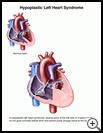
Hypoplastic Left Heart Syndrome
________________________________________________________________________
KEY POINTS
- Hypoplastic left heart syndrome is a rare birth defect of the heart. It means that several parts of the left side of a baby’s heart did not grow normally before birth.
- Treatment of hypoplastic left heart syndrome requires open-heart surgery within a few days to weeks after birth to create a new path for blood to flow through the lungs and to the body. Several more open-heart surgeries will be needed to complete the new path, usually before your child is 4 years old.
- Ask your child’s healthcare provider how to take care of your child at home.
________________________________________________________________________
What is hypoplastic left heart syndrome?
Hypoplastic left heart syndrome is a rare birth defect of the heart. It means that several parts of the left side of a baby’s heart did not grow normally before birth. The left side of the heart may be poorly developed, or may not have formed at all. The result is that the left side of the heart does not pump enough blood to the body. A baby with hypoplastic left heart syndrome may also have other heart defects.
Without surgery, a baby with hypoplastic left heart syndrome will die peacefully, usually within the first few days after birth. With surgery, many babies survive and have a relatively normal life.
What is the cause?
No one knows why the heart does not develop normally. However, if a family has 1 child with hypoplastic left heart syndrome, there is a higher risk that a sibling will also have it.
What are the symptoms?
Shortly after birth, babies are usually gray or blue, feed poorly, and do not grow. They cannot survive without treatment.
How is it diagnosed?
An ultrasound done during pregnancy or shortly after birth will show that the structures normally on the left side of the heart are poorly formed. Rarely, heart catheterization is needed to confirm the diagnosis before surgery. Heart catheterization uses a small tube called a catheter inserted into a blood vessel, contrast dye, and X-rays to look at the blood vessels and heart.
How is it treated?
Treatment of hypoplastic left heart syndrome requires open-heart surgery within a few days to weeks after birth to create a new path for blood to flow through the lungs and to the body. Several more open-heart surgeries will be needed to complete the new path, usually before your child is 4 years old. Until the first surgery can be done, the baby will need to be in a neonatal intensive care unit. He will have an IV for fluids and medicines. The medicines will help keep blood vessels open and decrease the workload on the heart and lungs. The baby may also need a breathing machine to help with breathing.
If these surgeries do not work, a heart transplant may sometimes be done.
After treatment, your child will need to see a cardiologist regularly for the rest of his life. Your child may need to take medicine to control his heart rate and to help the heart pump better. He may need to take antibiotics before dental work and some other procedures to prevent infection of the heart. He may also need more surgeries as he gets older.
How can I take care of my child?
Ask your child’s healthcare provider:
- How and when you will get your child’s test results
- How long it will take your child to recover
- If there are activities your child should avoid
- How to take care of your child at home
- What symptoms or problems you should watch for and what to do if your child has them
Make sure you know when your child should come back for a checkup. Keep all appointments for provider visits or tests.
Last modified: 2016-10-31
Last reviewed: 2016-10-31

